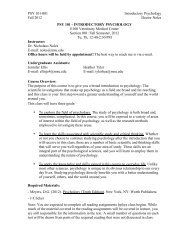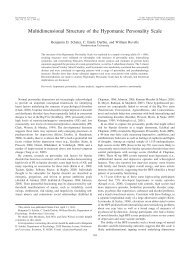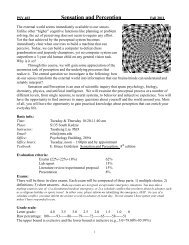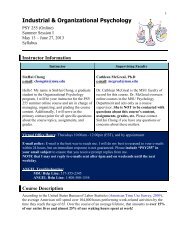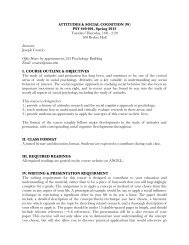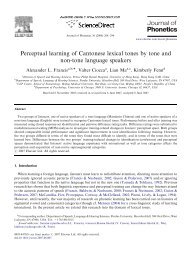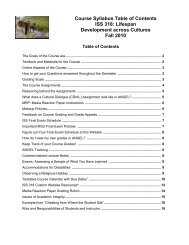Course Syllabus Table of Contents PSY 244 - Department of ...
Course Syllabus Table of Contents PSY 244 - Department of ...
Course Syllabus Table of Contents PSY 244 - Department of ...
Create successful ePaper yourself
Turn your PDF publications into a flip-book with our unique Google optimized e-Paper software.
2) After watching the Video Tool Kit video, Ch 3 Infertility and IVF (Duration 3 minutes) write an article for the<br />
magazine on IVF and ICSI (intra‐cytoplasmic sperm injection). What possible difficulties could arise as a result<br />
<strong>of</strong> the procedure in the video Why is it different than the procedures in Finland or Belgium [see the<br />
textbook for these details] Let your readers know your views on the current U.S. policy compared to those in<br />
other countries.<br />
What's Developing 3: Based on Chapters 5,6,7<br />
1) The Video Tool Kit video in Ch 6 on Affordances (Duration 0:43; this means 43 seconds) shows how two<br />
individuals can perceive the same object, the same environment, the same situation – yet they actually will<br />
observe and interpret the object, environment, situation in a completely different way. Use this concept as<br />
your background as you view the Ch 5 Video Tool Kit Video called, “Hothouse Babies” (Duration 1:55). The<br />
description that accompanies Hothouse Babies says, “Household toys and toys created by parents can<br />
provide all the stimulation children need.” Yet as you can see the mother in the video is concerned about<br />
providing the correct stimulus materials to ensure her child a positive academic future. Address the concerns<br />
that some <strong>of</strong> your readers may have since they want the best for their children as you explain cognitive<br />
development in the first two years.<br />
2) Watch, “Are Young Children Self Aware Lessons from the Animals” in the Ch 7 Video Tool Kit section<br />
(Duration 5:42) and integrate it with the section on self‐awareness and mirror recognition found in the<br />
textbook. The video presents two different views on animal self‐awareness; present both sides but let your<br />
readers know which view you feel is the stronger one.<br />
What's Developing 4: Based on Chapters 8,9,10<br />
1) Your readers might wonder why the salt that they buy on supermarket shelves says that it is “iodized”.<br />
Chapter 8 <strong>of</strong> the text explains that children may consume enough calories but still lack important nutrients.<br />
Watch the Video Tool Kit video in Ch 8 called, “Children in China with Iodine Deficiency” (Duration 6:42).<br />
Explain to your readers the necessity <strong>of</strong> eating a variety <strong>of</strong> foods, using iodine deficiency as your example.<br />
2) One <strong>of</strong> the Video Tool Kit videos in Ch 10 asks children how they would handle situations when grandparents<br />
gave them gifts that were not at all what they wanted. In “Learning Emotional Display Rules: The<br />
Disappointing Gift Task “(Duration 2:26) younger children report that they would handle the situation in quite<br />
different ways than do the older children. How does this relate to Emotional Development and to Sex and<br />
Gender as discussed in Chapter 10. Do you have a personal disappointing gift story to use as a hook that your<br />
readers would enjoy<br />
What's Developing 5: Based on Chapters 11,12,13<br />
1) The editor wants a story on teaching and learning (Chapter 12) which includes performance<br />
differences between boys and girls in the classroom which are revealed in the Video Tool Kit video<br />
in Ch 12, “Are Today’s Girls Academically Superior” (Duration: 5:46). Let the readers know the long term<br />
implications in terms <strong>of</strong> performance in adolescence, the college years, and career choices.<br />
2) In the early 1930s at a White House Conference it was <strong>of</strong>ficially declared that "Play is the Work <strong>of</strong> the Child".<br />
Explain why developmental research supports this view. Give an example from your own childhood <strong>of</strong><br />
something that you learned through play.<br />
Page 18




